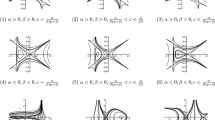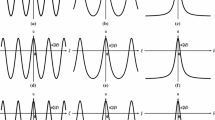Abstract
In this paper, the bifurcation analysis as well as the sub-equation expansion method will be applied to study the extended \((2+1)\)-dimensional Konopelchenko–Dubrovsky equations. The bifurcation analysis is first used to obtain the existence of traveling wave solutions. Then via the sub-equation expansion method, some new solitary-like wave solutions for each parameter condition are obtained.






Similar content being viewed by others
References
Xu, P.B., et al.: Soliton solutions, Bäcklund transformation and Wronskian solutions for the extended \((2+1)\)-dimensional Konopelchenko–Dubrovsky equations in fluid mechanics. Appl. Math. Comput. 218, 2489–2496 (2011)
Wazwaz, A.M.: New solitons and kink solutions for the Gardner equation. Commun. Nonlinear Sci. Numer. Simul. 12, 1395–1404 (2007)
Wazwaz, A.M.: Multiple-soliton solutions for the KP equation by Hirota’s bilinear method and by the tanh–coth method. Appl. Math. Comput. 190, 633–640 (2007)
Li, L.L., et al.: On a generalized Kadomtsev–Petviashvili equation with variable coefficients via symbolic computation. Phys. Scr. 76, 411–417 (2007)
Soomere, T.: Interaction of Kadomtsev–Petviashvili solitons with unequal amplitudes. Phys. Lett. A 332, 74–81 (2004)
Khalique, C.M., Adem, A.R.: Exact solutions of a generalized \((3+1)\)-dimensional Kadomtsev–Petviashvili equation using Lie symmetry analysis. Appl. Math. Comput. 216, 2849–2854 (2010)
Sun, Z.Y., et al.: Inelastic interactions of the multiple-front waves for the modified Kadomtsev–Petviashvili equation in fluid dynamics, plasma physics and electrodynamics. Wave Motion 46, 511–521 (2009)
Konopelcheno, B.G., Dubrovsky, V.G.: Some integrable nonlinear evolution equations in dimensions. Phys. Lett. A 102, 15–17 (1984)
Bekir, A.: Applications of the extended tanh-method for coupled nonlinear evolution equations. Commun. Nonlinear Sci. Numer. Simul. 13, 1748–1757 (2008)
Jiang, Z., Bullough, R.K.: Combined and Riemann–Hilbert inverse methods for integrable nonlinear evolution equations in \((2+1)\) dimensions. J. Phys. A Math. Gen. 20, L429–L435 (1987)
Lin, J., Lou, S.Y., Wang, K.L.: Multi-soliton solutions of the Konopelchenko–Dubrovsky equation. Chin. Phys. Lett. 18, 1173–1175 (2001)
Wang, D.S., Zhang, H.Q.: Further improved F-expansion method and new exact solutions of Konopelchenko–Dubrovsky equation. Chaos Solitons Fractals 25, 601–610 (2005)
Li, J.B., Liu, Z.R.: Smooth and non-smooth traveling waves in a nonlinearly dispersive equation. Appl. Math. Model. 25, 41–56 (2000)
Rui, W.G.: The integral bifurcation method combined with factoring technique for investigating exact solutions and their dynamical properties of a generalized Gardner equation. Nonlinear Dyn. 76, 1529–1542 (2014)
Li, S.Y., Li, Y., Zhang, B.G.: Some singular solutions and their limit forms for generalized Calogero–Bogoyavlenskii–Schiff equation. Nonlinear Dyn. 85, 1665–1677 (2016)
Li, S.Y., Liu, Z.R.: Kink-like wave and compacton-like wave solutions for generalized KdV equation. Nonlinear Dyn. 79, 903–918 (2015)
Liu, Z.R., Liang, Y.: The explicit nonlinear wave solutions and their bifurcations of the generalized Camassa-Holm equation. Int. J. Bifurc. Chaos 21, 3119–3136 (2011)
Wen, Z.S.: Bifurcation of solitons, peakons, and periodic cusp waves for \(\theta \)-equation. Nonlinear Dyn. 77, 247–253 (2014)
Song, M.: Nonlinear wave solutions and their relations for the modified Benjamin–Bona–Mahony equation. Nonlinear Dyn. 80, 431–446 (2015)
Song, M., Liu, Z.R., Biswas, A.: Soliton solution and bifurcation analysis of the KP-Benjamin–Bona–Mahoney equation with power law nonlinearity. Nonlinear Anal. Model. Control 20, 417–427 (2015)
Song, M., Liu, Z.R.: Periodic wave solutions and their limits for the ZK–BBM equation. Appl. Math. Comput. 232, 9–26 (2014)
Chen, Y., Li, B.: General projective Riccati equation method and exact solutions for generalized KdV-type and KdV-Burgers-type equations with nonlinear terms of any order. Chaos Solitons Fractals 19, 977–984 (2004)
Chen, Y., Li, B., Zhang, H.Q.: Symbolic computation and construction of soliton-like solutions to the \((2+1)\)-dimensional breaking soliton equation. Commun. Theor. Phys. 40(2), 137–142 (2003)
Li, B., Chen, Y.: On exact solutions of the nonlinear Schr\({\ddot{o}}\)dinger equations in optical fiber. Chaos Solitons Fractals 21, 241–247 (2004)
Li, B., Chen, Y., Zhang, H.Q.: Explicit exact solutions for new general two-dimensional KdV-type and two-dimensional KdV-Burgers-type equations with nonlinear terms of any order. J. Phys. A Math. Gen. 35, 8253–8265 (2002)
Li, B., Chen, Y., Zhang, H.Q.: Auto-B\({\ddot{a}}\)klund transformation and exact solutions for compound KdV-type and compound KdV-burgers-type equations with nonlinear terms of any order. Phys. Lett. A 305, 377–382 (2002)
Yan, Z.Y.: Generalized method and its application in the higher-order nonlinear Schrodinger equation in nonlinear optical fibres. Chaos Solitons Fractals 16, 759–766 (2003)
Wadati, M.: Wave propagation in nonlinear lattice. I. J. Phys. Soc. Jpn. 38, 673–679 (1975)
Wang, D.S., Zhang, H.Q.: Further improved F-expansion method and new exact solutions of Konopelchenko–Dubrovsky equation. Chaos Solitons Fractals 25, 601–610 (2005)
Song, L.N., Zhang, H.Q.: New exact solutions for the Konopelchenko–Dubrovsky equation using an extended Riccati equation rational expansion method and symbolic computation. Appl. Math. Comput. 187, 1373–1388 (2007)
Acknowledgements
All authors wish to thank the editor and the anonymous referee for many valuable suggestions leading to an improvement of this paper. This work was partially supported by National Natural Science Foundation of China (Grant Nos. 11571116, 11501373, and 11601340), Natural Science Foundation of Guangdong Province (No. S2016010020464 and No. S2016010030049 ), Education research platform project of Guangdong Province (No. 2014KQNCX208), Education Reform Project of Guangdong Province (No. 2015558), Shaoguan Science and Technology Foundation (No. 20157212 and No. 20157201), Education Reform Project of Shaoguan University (SYJY20151643 and SYJY20141576), Science Foundation of Shaoguan University (SZ2016KJ04).
Author information
Authors and Affiliations
Corresponding author
Appendix A: some solutions of Eq. (3.3).
Appendix A: some solutions of Eq. (3.3).
Case (1) Kink-shaped solitary-like wave solutions.
(I). If \(d_0=\frac{{d_2}^2}{4d_4}, d_1=d_3=0, d_2 < 0, d_4>0\), then Eq. (3.3) has a kink-shaped solitary-like wave solution
If \(d_0=\displaystyle \frac{{d_2}^2}{4d_4}, d_1=d_3=0, d_2> 0, d_4 > 0\), then Eq. (3.3) has a kink-shaped solitary-like wave solution
If \(d_0=d_1=0, d_3\ne 0, d_2 > 0, d_4 =c\), then Eq. (3.3) has a kink-shaped solitary-like wave solution
If \(d_0=d_1=0, d_3\ne 0, d_2 > 0, d_4 =c\), then Eq. (3.3) has a kink-shaped solitary-like wave solution
(II). Bell-shaped solitary-like wave solutions.
If \(d_0=d_1=d_3=0, d_2 > 0, d_{4} < 0\), then Eq. (3.3) has a bell-shaped solitary-like wave solution
If \(d_0=d_1=d_3=0, d_2 < 0, d_4 > 0\), then Eq. (3.3) has a bell-shaped solitary-like wave solution
If \(d_0>0,d_1=d_3=d_4=0, d_2 > 0\), then Eq. (3.3) has a bell-shaped solitary-like wave solution
If \(d_1\ne 0,d_0=d_3=d_4=0, d_2 > 0\), then Eq. (3.3) has a bell-shaped solitary-like wave solution
If \(d_0=d_1=d_4=0, d_2>0\), then Eq. (3.3) has a bell-shaped solitary-like wave solution
If \(d_0=d_1=d_4=0,d_2<0\), then Eq. (3.3) has a bell-shaped solitary-like wave solution
(III). Solitary-like wave solutions (1).
If \(d_1=d_3=d_4=0, d_0>0, d_2<0\), then Eq. (3.3) has a solitary-like wave solution
If \(d_0=d_3=d_4=0, d_1\ne 0, d_2<0\), then Eq. (3.3) has a solitary-like wave solution
If \(d_0=d_1=d_2=0, d_3\ne 0, d_4<0\), then Eq. (3.3) has a solitary-like wave solution
If \(d_0=\displaystyle \frac{d^{2}_1}{4d_2}, d_1=c, d_2>0, d_3=d_4=0\), then Eq. (3.3) has a solitary-like wave solution
If \(d_0=c, d_1\ne 0, d_2=0, d_3=d_4=0\), then Eq. (3.3) has a solitary-like wave solution
If \(d_0>0, d_1=d_2=0, d_3=d_4=0\), then Eq. (3.3) has a solitary-like wave solution
(IV). Solitary-like wave solutions(2).
If \(d_0=d_1=0, d_2> 0, d_3=c, d_{4}>0\), then Eq. (3.3) has a solitary-like wave solution
If \(d_0=d_1=0, d_2> 0, d_3=c, d_{4}>0\), then Eq. (3.3) has a solitary-like wave solution
If \(d_0=d_1=0, d_2 < 0, d_3=c, d_{4}>0\), then Eq. (3.3) has a solitary-like wave solution
If \(d_0=d_1=0, d_2 < 0, d_3=c, d_{4}>0\), then Eq. (3.3) has a solitary-like wave solution
If \(d_0=d_1=0, d_2 > 0, d_{3}=d_{4}=c\), then Eq. (3.3) has a solitary-like wave solution
If \(d_0=d_1=0, d_2 < 0, d_{3}=d_{4}=c\), then Eq. (3.3) has a solitary-like wave solution
If \(d_0=d_1=0, d_2 < 0, d_{3}=d_{4}=c\), then Eq. (3.3) has a solitary-like wave solution
If \(d_0=d_1=0, d_2 > 0, d_{3}=d_{4}=c\), then Eq. (3.3) has a solitary-like wave solution
If \(d_0=d_1=0, d_2 > 0, d_{3}\ne 0, d_{4}=c\), then Eq. (3.3) has a solitary-like wave solution
If \(d_0=d_1=0, d_2 > 0, d_{3}\ne 0, d_{4}=c\), then Eq. (3.3) has a solitary-like wave solution
If \(d_0=d_1=0, d_2 > 0, d_{3}=d_{4}=c\), then Eq. (3.3) has a solitary-like wave solution
If \(d_0=d_1=0, d_2 > 0, d_{3}=d_{4}=c\), then Eq. (3.3) has a solitary-like wave solution
Case (2) Jacobi-like and Weierstrass-like doubly periodic solutions.
If \(d_{1}=d_{3}=0, d_4 < 0, d_2 > 0, d_0= \displaystyle \frac{{d_2 ^2 m^2 (1 - m)^2}}{{d_4 (2m^2-1)^2 }}\), then Eq. (3.3) has a Jacobi-like and Weierstrass-like doubly periodic solution
If \(d_{1}=d_{3}=0, d_4 < 0, d_2> 0, d_0= \displaystyle \frac{{d_2 ^2 (1 - m^2 )}}{{d_4 (2 - m^2)^2 }}\), then Eq. (3.3) has a Jacobi-like and Weierstrass-like doubly periodic solution
If \(d_{1}=d_{3}=0, d_4> 0, d_2 < 0, d_0= \displaystyle \frac{{d_2 ^2 m^2 }}{{d_4 (m^2 + 1)^2}}\), then Eq. (3.3) has a Jacobi-like and Weierstrass-like doubly periodic solution
where m is a modulus.
where \(g_2=-4\displaystyle \frac{d_1}{d_3}\) and \(g_3=-4\displaystyle \frac{d_0}{d_3}\).
Rights and permissions
About this article
Cite this article
Li, Y., Li, S. & Wei, R. Bifurcation analysis and solitary-like wave solutions for extended \({{\varvec{(2+1)}}}\)-dimensional Konopelchenko–Dubrovsky equations. Nonlinear Dyn 88, 609–622 (2017). https://doi.org/10.1007/s11071-016-3264-5
Received:
Accepted:
Published:
Issue Date:
DOI: https://doi.org/10.1007/s11071-016-3264-5
Keywords
- Extended \((2+1)\)-dimensional Konopelchenko–Dubrovsky equations
- Bifurcation analysis
- Solitary-like wave solutions
- Sub-equation expansion method




